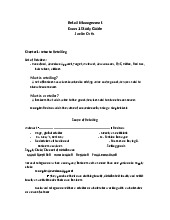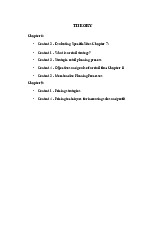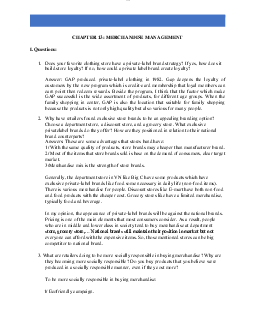



Preview text:
lOMoAR cPSD| 58097008 QUIZ 3 I. Writing Question Question 1: • Answer:
The retailers attempting to maintain an EDLP strategy because of the benefits: -
Assures customers at low price: Many customers determine price priority. They've
gotten conditioned to only buy on sale, which is the hallmark of a high/low price approach.
Customers can expect the same low pricing every time thanks to the EDLP and buy
merchandise immediately. Customers don't have to browse the classified advertising or wait
for their desired things to go on sale. -
Reduces advertising and operating expenses: The EDLP-induced pricing stability
reduces the requirement for the high/low strategy's weekly-sale advertising. Moreover, EDLP
retailers avoid the labor expenditures of updating price tags and signs, as well as putting up sale signs. -
Reduces stockouts and improves inventory management: The EDLP method
reduces huge changes in demand produced by frequent large discount sales. As a result,
retailers may more confidently manage inventory. A more predictable customer demand pattern
also allows the sellers to improve inventory turnover by lowering the average inventory
required for special promotions and backup stock.
Although some retailers use every-low-price (EDLP) strategy, others have high/low pricing to
promote frequent sales because of its advantages including: -
Increases profits: High/low pricing allows retailers to charge higher prices to non-
pricesensitive customers who will pay the "high" price, and lower prices to price-sensitive
customers who will wait for the "low" discount price. -
Creates excitement: Sales attract a large number of consumers, and a large number of
customers generates excitement. Low prices and advertising are supplemented with special
instore activities such as product demonstrations, freebies, and celebrity appearances at some businesses. Question 2: • Answer:
The term “brand” is the name, symbol, design or any features that identifies particular
company, products or individuals. “Brands” make seller’s goods or service are distinctive from
others. Brands are intangible, which means they cannot be touched or seen. Brands are used in
business, marketing, and advertising for recognition and, importantly, to create and store value lOMoAR cPSD| 58097008
as brand equity for the object identified, to the benefit of the brand's customers, its owners and shareholders.
If a customer is happy with your products or services, a solid brand image helps to build
customer loyalty across your business. When a consumer buys a product or service, he is not
just buying a product or service; he is buying what your brand stands for. That’s why it is
extremely important to design your brand image to convey exactly what you want it to say. A
strong image of your brand can deliver benefits to your organization. Here are the reasons why
brand image is so important for retailers:
1/ Customers' decision-making processes can be influenced by strong brand names, which can
encourage repeat visits and purchases as well as foster loyalty. Furthermore, powerful brand
names allow retailers to demand higher prices while reducing their marketing expenses.
2/ Customer loyalty to brands is based on increased brand awareness and emotional
attachments. Some retail brands, like Walmart and Macy's, are so well-known among
consumers that they frequently feature in their consideration sets. Moreover, customers identify
with certain brands and have strong emotional attachments to them. Going to Target, for
example, has become a nice experience because people believe it is trendy to save money while
purchasing fashionable products in the same place. Customers affectionately use the faux
French pronunciation of “Tar-zhay” when referring to Target. High brand awareness and strong
emotional connections reduce the incentive of customers to switch to competing retailers. A
strong brand image also enables retailers to increase their margins. When shops have a high
level of customer loyalty, they can use premium pricing to entice customers rather than relying
on price promotions. To sustain market share, brands with a poor image are pushed to offer low
pricing and frequent reductions.
3/ Retailers with strong brand names can use their names to promote new retail concepts with
little marketing resources. The Gap, for example, has successfully expanded its brand to
include GapKids, gapbody, GapMaternity, and babyGap, while Toys "R" Us has expanded its
brand name to include Babies "R" Us. lOMoAR cPSD| 58097008 II. Exercises Question 1: • Answer: a)
The A items account for only 5 percent of the SKUs in the category but represent 70 percent of
sales which should never be out of stock or should be in stock list. Therefore, the SKUs 1, 3,
6, 7, 14, 2, 5, 15, and 8 account for approximate 70 percentage of annual sales which should
never be out of stock. However, the C items account for 10 percent of sales which is the lowest
consumption level. Thus, the SKUs in C class should not be in stock list. b)
GMROI is a financial ratio that assesses a buyer’s contribution to a company, which is gross
margin return on inventory investment (GMROI, typically pronounced “jim-roy”). It measures
how many gross margin dollars are earned on every dollar of inventory investment made by the buyer.
Inventory turnover, which measures how effectively retailers utilize their investment in
inventory, is another important ratio for assessing retail performance. =>
𝑁𝑒𝑡 𝑆𝑎𝑙𝑒𝑠
𝑆𝑎𝑙𝑒𝑠 − 𝑡𝑜 − 𝑆𝑡𝑜𝑐𝑘 𝑅𝑎𝑡𝑖𝑜 =
𝐴𝑣𝑒𝑟𝑎𝑔𝑒 𝑖𝑛𝑣𝑒𝑛𝑡𝑜𝑟𝑦 𝑎𝑡 𝑐𝑜𝑠𝑡
𝐼𝑛𝑣𝑒𝑛𝑡𝑜𝑟𝑦 𝑡𝑢𝑟𝑛𝑜𝑣𝑒𝑟 = (1 − 𝐺𝑟𝑜𝑠𝑠 𝑀𝑎𝑟𝑔𝑖𝑛 𝑃𝑒𝑟𝑐𝑒𝑛𝑡) 𝑆𝑎𝑙𝑒𝑠 − 𝑡𝑜 − 𝑆𝑡𝑜𝑐𝑘 𝑟𝑎𝑡𝑖𝑜
𝐺𝑀𝑅𝑂𝐼 = 𝐺𝑟𝑜𝑠𝑠 𝑀𝑎𝑟𝑔𝑖𝑛 𝑃𝑒𝑟𝑐𝑒𝑛𝑡 𝑆𝑎𝑙𝑒𝑠 − 𝑡𝑜 − 𝑆𝑡𝑜𝑐𝑘 𝑟𝑎𝑡𝑖𝑜 c) lOMoAR cPSD| 58097008 -
In the A class: 4 SKUs that have the highest inventory turnover level are items 3, 6, 14,
and 2. However, items 3 and 6 have the highest GMROI which earn more profit than others,
so the company should invest in items 3 and 6. -
In the B class: While items 12 and 13 have the highest inventory turnover, item 12 has
the highest GMROI. So, it should be invested. -
In the C class: Item 11 has the highest inventory turnover as well as GMROI. Therefore,
it should be invested in this class. Question 2: • Answer:
The markup percentage for black leather belts is:
𝑅𝑒𝑡𝑎𝑖𝑙 𝑝𝑟𝑖𝑐𝑒−𝐶𝑜𝑠𝑡 𝑜𝑓 𝑏𝑒𝑙𝑡𝑠 $32−$22 Markup percentage = == 31.25%
𝑅𝑒𝑡𝑎𝑖𝑙 𝑃𝑟𝑖𝑐𝑒 $32 Question 3: • Answer:
The final selling price of Sofa is:
Final selling price = Cost of Sofa *(1 + markup)*(1 - markdown)
= $300*(1 + 0.50)*(1 – 0.30) = $315


